hair loss in
men & women
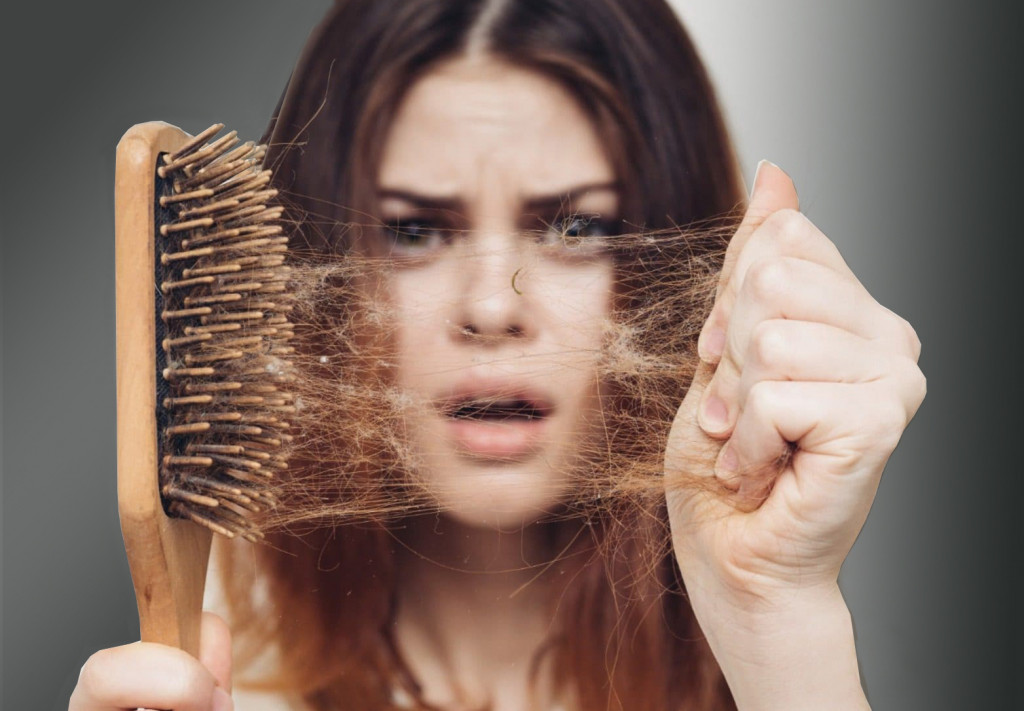
Hair is made up of a protein called keratin that is produced in hair follicles in the outer layer of the skin. As follicles produce new hair cells, old cells are being pushed out through the surface of the skin at the rate of about six inches a year. The hair you can see is actually a string of dead keratin cells. The average adult head has about 100,000 to 150,000 hairs and loses up to 100 of them a day; finding a few stray hairs on your hairbrush is not necessarily cause for alarm.
Each follicle has its own life cycle that can be influenced by age, disease, and a wide variety of other factors. This life cycle is divided into three phases:
- Anagen — active hair growth that generally lasts between two to eight years
- Catagen — transitional hair growth that lasts two to three weeks
- Telogen — resting phase that lasts about two to three months; at the end of the resting phase the hair is shed and a new hair replaces it and the growing cycle starts again.
As people age, their rate of hair growth slows.
Types of hair loss
Involutional alopecia is a natural condition in which the hair gradually thins with age. More hair follicles go into the resting phase, and the remaining hairs become shorter and fewer in number.
Androgenic alopecia is a genetic condition that can affect both men and women. Men with this condition, called male pattern baldness, can begin suffering hair loss as early as their teens or early 20s. It’s characterized by a receding hairline and gradual disappearance of hair from the crown and frontal scalp. Women with this condition, called female pattern baldness, don’t experience noticeable thinning until their 40s or later. Women experience a general thinning over the entire scalp, with the most extensive hair loss at the crown.
Alopecia areata often starts suddenly and causes patchy hair loss in children and young adults. This condition may result in complete baldness (alopecia totalis). But in about 90% of people with the condition, the hair returns within a few years.
Alopecia universalis causes all body hair to fall out, including the eyebrows, eyelashes, and pubic hair.
Trichotillomania, seen most frequently in children, is a psychological disorder in which a person pulls out one’s own hair.
Telogen effluvium is temporary hair thinning over the scalp that occurs because of changes in the growth cycle of hair. A large number of hairs enter the resting phase at the same time, causing hair shedding and subsequent thinning. Learn more about what causes telogen effluvium.
Scarring alopecias result in permanent loss of hair. Inflammatory skin conditions (cellulitis, folliculitis, acne), and other skin disorders (such as some forms of lupus and lichen planus) often result in scars that destroy the ability of the hair to regenerate. Hot combs and hair too tightly woven and pulled can also result in permanent hair loss.
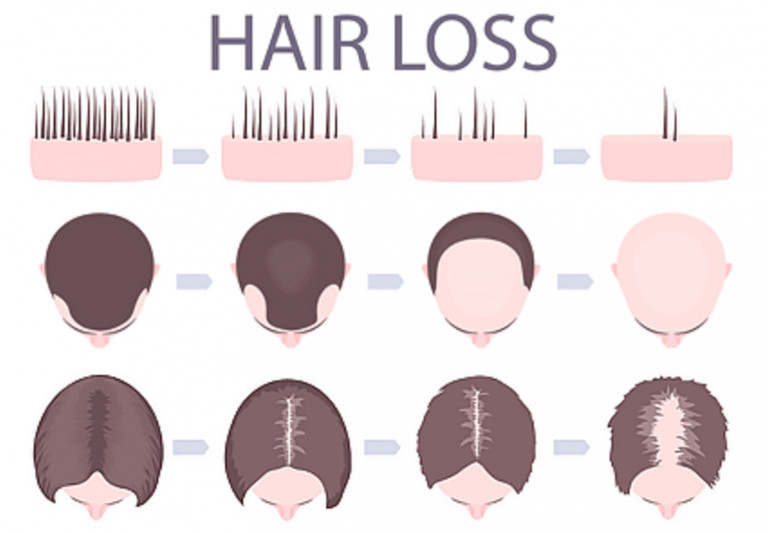
What causes hair loss?
Hair loss has many causes. What’s causing your hair loss can determine whether your hair:
- Falls out gradually or abruptly
- Thins
- Can regrow on its own
- Requires treatment to regrow
- Needs immediate care to prevent permanent hair loss
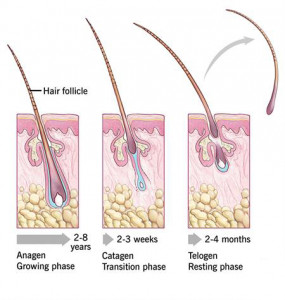
Causes of hair loss
Hereditary hair loss
Both men and women develop this type of hair loss, which is the most common cause of hair loss worldwide. In men, it’s called male pattern hair loss. Women get female pattern hair loss. Regardless of whether it develops in a man or woman, the medical term is androgenic alopecia.
This means that you’ve inherited genes that cause your hair follicles (what each hair grows out of) to shrink and eventually stop growing hair. Shrinking can begin as early as your teens, but it usually starts later in life.
In women, the first noticeable sign of hereditary hair loss is usually overall thinning or a widening part.
When a man has hereditary hair loss, the first sign is often a receding hairline or bald spot at the top of his head.
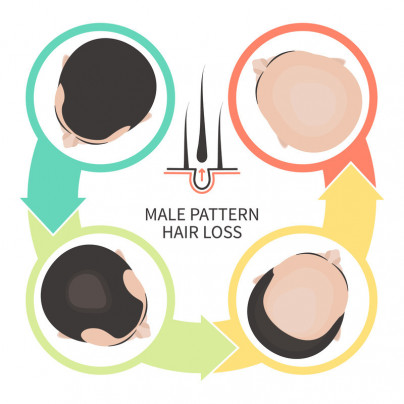
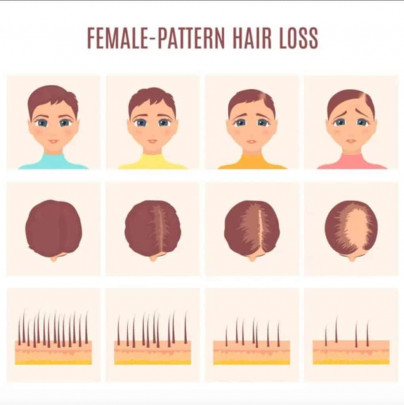
Alopecia areata
Alopecia areata is a disease that develops when the body’s immune system attacks hair follicles (what holds the hair in place), causing hair loss. You can lose hair anywhere on your body, including your scalp, inside your nose, and in your ears. Some people lose their eyelashes or eyebrows.
Cancer treatment
If you receive chemotherapy or have radiation treatment to your head or neck, you may lose all (or most of) your hair within a few weeks of starting treatment.
Childbirth, illness, or other stressors
A few months after giving birth, recovering from an illness, or having an operation, you may notice a lot more hairs in your brush or on your pillow. This can also happen after a stressful time in your life, such as a divorce or the death of a loved one.
Hairstyle pulls on your scalp
If you often wear your hair tightly pulled back, the continual pulling can lead to permanent hair loss. The medical name for this condition is traction alopecia.
Hormonal imbalance
A common cause of this imbalance is polycystic ovary syndrome (PCOS). It leads to cysts on a woman’s ovaries, along with other signs and symptoms, which can include hair loss. Stopping some types of birth control pills can cause a temporary hormonal imbalance. Women who develop a hormonal imbalance can develop thinning hair (or hair loss) on their scalp.
Scalp psoriasis
Many people who have plaque psoriasis develop psoriasis on their scalp at some point. This can lead to hair loss.
Pulling your hair
Some people pull on their hair, often to relieve stress. They may be unaware that they’re pulling their hair. The medical term for this is trichotillomania.
Scalp infection
Scalp infection can lead to scaly and sometimes inflamed areas on your scalp. You may see what look like small black dots on your scalp. These are actually stubs of hair. Some people develop a bald spot.
Medication
A possible side effect of some medications is hair loss. If you think a medication is causing your hair loss, ask the doctor who prescribed it if hair loss is a possible side effect. It’s essential that you do not stop taking the medication before talking with your doctor. Abruptly stopping some medications can cause serious health problems.
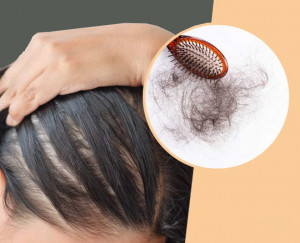
Scarring alopecia
This condition develops when inflammation destroys hair follicles. Once destroyed, a hair follicle cannot grow hair. Diverse conditions can cause this. The medical name for this group of conditions is cicatricial alopecia.
Sexually transmitted infection
Left untreated, a sexually transmitted infection (STI) can lead to hair loss. Syphilis is such an STI. Left untreated, syphilis can cause patchy hair loss on the scalp, eyebrows, beard, and elsewhere. Other STIs can also cause hair loss.
Thyroid disease
If you have a problem with your thyroid, you may see thinning hair. Some people notice that their hair comes out in clumps when they brush it.
Too little biotin, iron, protein, or zinc
If you’re not getting enough of one or more of these, you can have noticeable hair loss.
Poison
Being slowly poisoned can lead to hair loss. Poisons that can cause hair loss include arsenic, thallium, mercury, and lithium. If you ingest a large amount of warfarin, which is found in rat poisons, it can also cause hair loss. Taking large amounts of vitamin A or selenium is also toxic and can cause hair loss.

